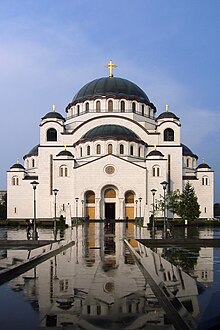Temple of Saint Sava
| Church of Saint Sava Храм светог Саве Hram svetog Save |
|
|---|---|

Front view of the church
|
|
| Basic information | |
| Location | Vračar, Belgrade, Serbia |
| Geographic coordinates | 44°47′53.1″N 20°28′6.78″E / 44.798083°N 20.4685500°ECoordinates: 44°47′53.1″N 20°28′6.78″E / 44.798083°N 20.4685500°E |
| Affiliation | Serbian Orthodox |
| Website | Official website (Serbian) |
| Architectural description | |
| Architect(s) |
Aleksandar Deroko Branko Pešić |
| Architectural type | Serbo-Byzantine/Neo-Byzantine |
| Completed | 1989 |
| Specifications | |
| Capacity | 10,800 (inner) |
| Interior area | 170,000 cubic meters |
| Height (max) | 79 m (259 ft) |
| Dome height (outer) | 70 m (230 ft) |
| Dome height (inner) | 65 m (213 ft) |
The Church of Saint Sava (Serbian: Храм светог Саве/Hram svetog Save, literal translation into English: "The Temple of Saint Sava") is a Serbian Orthodox church located on the Vračar plateau in Belgrade. It is one of the largest Orthodox churches in the world and ranks among the largest church buildings in the world.
The church is dedicated to Saint Sava, the founder of the Serbian Orthodox Church and an important figure in medieval Serbia. It is built on the Vračar plateau, on the location where his remains were burned in 1595 by Ottoman Grand Vizier Sinan Pasha. From its location, it dominates Belgrade's cityscape, and is perhaps the most monumental building in the city.
In 1594, Serbs rose up against Ottoman rule in Banat, during the Long War (1591–1606) which was fought at the Austrian-Ottoman border in the Balkans. The Serbian patriarchate and rebels had established relations with foreign states, and had in a short time captured several towns, including Vršac, Bečkerek, Lipova, Titel and Bečej, although the uprising was quickly suppressed. The rebels had, in the character of a holy war, carried war flags with the icon of Saint Sava.
The war banners had been consecrated by Patriarch John I Kantul, whom the Ottoman government later had hanged in Istanbul. Ottoman Grand Vizier Sinan Pasha ordered that the sarcophagus and relics of Saint Sava located in the Mileševa monastery be brought by military convoy to Belgrade. Along the way, the Ottoman convoy had people killed in their path so that the rebels in the woods would hear of it. The relics were publicly incinerated by the Ottomans on a pyre on the Vračar plateau, and the ashes scattered, on 27 April 1595. According to Nikolaj Velimirović the flames were seen over the Danube.
...
Wikipedia
